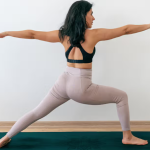Being a yoga teacher is a great job. You’re doing something you love, and teaching other people to love yoga as much as you do. But there’s a lot more to being a yoga teacher than just teaching yoga.
Students don’t just turn up by magic – sadly. In order to get students through your door, and then keep them coming, you need to do some marketing. Which for some yoga teachers is a thing they love to hate.
If you have a background in marketing then congratulations, you’ve got a big advantage! But most of us don’t, and have to learn from scratch how to keep our classes full. So here’s a basic ‘how-to’ of yoga marketing, just to get you started. And who knows, you might even start to enjoy it!
Your Yoga website
Some teachers maintain that they don’t need a website, and use Facebook and other social media to get their details out there. Others think that having a website means that there’s a more structured way that potential students can search for you and find out information. It’s up to you, but as a way of controlling and updating your ‘brand’ image, as well as coming up in Google searches, having a website is very helpful.
It’s worth bearing in mind that having a website is an extra cost, as you have to pay an annual fee for the domain name, the site, and fees for other ‘add ons’ (for example, you opt for an email address to go with your website).
Squarespace and WordPress are popular website platforms, but there are loads of well-designed platforms out there that make it easy to build and maintain your website. Wix and Mailchimp are also currently offering a free website-building service – although it’s worth noting Mailchimp’s offering is pretty basic at this stage as it’s not their core product (see Mailchimp Emails, below!).
The key is to keep it simple. Look at other yoga teacher’s websites that you admire, and take notes. Keep your home page uncluttered, clear – and don’t forget to keep it updated.
A Yoga Blog
A regular blog is a great way to keep your students engaged, and it should also mean that your website goes higher up the Google search list. The key is to keep it regular though, so once you’ve decided to write one, think about how often is realistic. For example, publishing a monthly blog can fit into most people’s schedules. It also means you’re not filling up the inboxes of your email list.
Mailchimp Emails
And talking of email lists, Mailchimp is a pretty essential marketing tool. It’s also free up to a certain amount of people. Find a way of collecting every student’s email address. For example, you could use a medical form that you give to every student who attends your classes. As part of the form you can ask for their email address, just make sure to add a clear paragraph about them agreeing to be sent information, in line with the GDPR (General Data Protection Regulation) that came in in 2018.
You could also add a landing page to your website, perhaps offering something for free in exchange for an email address. That way you can grow your mailing list from online sources.
Use your Mailchimp email list to notify students and prospective students about upcoming workshops, or send out your blog to your students before posting it on your website. Regular contact using high-quality content will keep you in mind and mean that they’re more likely to get in touch.
Taking Online Bookings
The current crisis has highlighted our reliance on the internet, and this is set to increase, especially as cash is being avoided at the moment. As up-to-date yoga teachers, it’s worth working out how to take online bookings for your classes.
In order to set up online bookings for regular lessons, you can use scheduling apps that link to your website. Many yoga studios use Mindbody as an external booking system for the classes. Or, using Paypal or Stripe, for example, you can set up a ‘products’ page on your website, so that people can pay for each class separately.
Posting on Social Media
The main social media platforms are Facebook, Instagram and Twitter. Each one is used in slightly different ways and attract different users.
Starting your own Facebook page is a useful way of reaching out to local people, Instagram is about the yoga community, and Twitter is more about interesting info on the subject.
Once you get into posting on social media this is when the small job of marketing can consume your every waking hour. It’s helpful to pick a platform that you feel the most comfortable on – being aware of your target market too. For example, if you’re going for slightly older students, then Facebook is probably the platform.
Once you’ve decided which one to focus on you can start to get organised, using a scheduling tool such as buffer. Due to the algorithms that these platforms are run on, you have to keep up a regular stream of posts in order to come high up in people’s news feeds.
However, there’s a balance. Some experts would have you posting twenty times a day, but personally I feel this would make me come across like some demented egomaniac. Be consistent, engage with your audience, and make sure you believe in the content that you’re putting up; quality is important.
Leaflets, Flyers, and Posters
This may not be relevant just yet, but once we’re out of lockdown, people will be out and about again and possibly desperate to get back to in-person yoga (when it’s safe to do so, and when you’re ready). This is when good old-fashioned flyers can do the trick, especially if you’re hoping to get new students in your local area.
Keep your posters, simple, colourful and with only the KEY information – don’t write an essay, no one will read it and it will distract from your eye-catching image.
To design your poster you can use apps such as Canva and Adobe Indesign in order to give your finished piece a professional look. Canva in particular is a great tool for non-designers, as it’s extremely easy to use and comes with lots of (free) templates.
Images
Before you do any of the above you’ll need to have some good images. You can, of course, buy high-resolution images (please don’t use low-res pixelated images on your marketing material) from websites such as Shutterstock (as well as some good free ones on Pexels), but having some great pictures of you in action will be worth the money.
Check out images of other yoga teachers that you like and ask them who took their photos. It’s helpful to find a photographer that specialises in yoga photography as they’ll be able to guide you on the shoot.
Have a wide range of photos taken in different outfits and with different backgrounds. If possible, having a few with a plain white background is very useful for flyers and as background pictures.
Word of Mouth
Marketing is important. But it’s also about putting the time in. Once you’ve been teaching regular classes for a few years you will find that you’ve developed a yoga community of your own. You will have regular students who tell their friends about you, and suddenly you’ll find that you haven’t had to do a hard marketing push for a while.
However, this doesn’t mean it’s time to rest on your laurels. There are always reasons why people stop coming to yoga, and you’ll always need new students coming through your doors.













